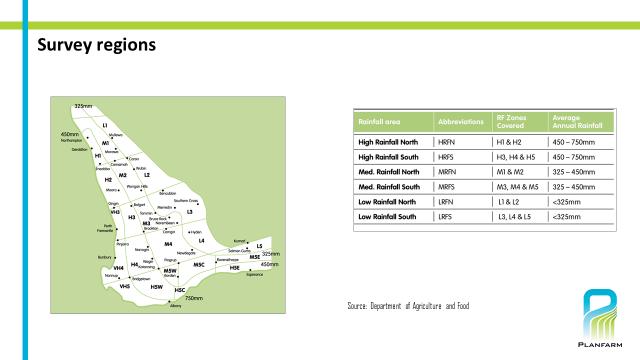Drivers of farm business - what keeps the top 25% at the top?
Author: Greg Kirk and Eric Hall (Planfarm) | Date: 23 Mar 2015
Take home messages
- Know your numbers.
- Have a strategy to achieve your goals.
- Small things do matter.
- Pay attention to the detail.
Background
Planfarm are a Western Australian agricultural consultancy firm who advise farm owners and operators on ways to lift performance and achieve better outcomes from their businesses. In a typical year our diverse clientele produce around three million tonne of grain, 700,000 lambs and seven million kilograms of wool.
Through our benchmarking program, which now extends over thirty years we have been able to identify those businesses which consistently outperform their peers. This presentation today will share with you the key messages we have learned across this time.
Methodology
This paper presents results from the annual Planfarm Bankwest Benchmarks, a comprehensive annual farm business analysis undertaken by Planfarm using data supplied by Planfarm, Bankwest, and the consulting firms; Bedbrook Johnston Williams, Business Ag and Ag Asset.
The 2013-14 edition comprised data from 566 farm businesses throughout the broadacre regions of WA (Figure 1).

Figure 1. Broadacre regions of WA.
To gain more insight into the longer term performances of farm businesses, results are also presented from the top performing businesses over a rolling six year period. To protect privacy all results presented are anonymous and comprise averages of individual client performance.
In addition to benchmarking data we report on our experience over twenty odd years working with a range of farm businesses who have a track record of resilience and profitability over an extended period.
Results and discussion
“If you can measure it, you can manage it”.
Knowing what the key metrics are for your business and how well you are performing in these key areas allows you to focus on the important as distinct from just the urgent. Grain yield and price are key drivers of farm profitability in the wheatbelt and every grain producer aims to maximise both of these numbers. There is more to benchmarking than just that. Indeed it is possible to have both yield and price in the top quartile and still have a business which is struggling to make progress and deliver against goals.
Knowing your numbers gives you confidence in your decision making especially around capital investment in more land or machinery and is also essential for development of your individual business strategy.
Having the right business strategy is a common theme among top performing businesses both in and outside agriculture. A good strategy even if implementation is only average will always beat a poor strategy no matter how well it is implemented. Knowing your numbers makes it easy to assess what impact a particular strategy will have on your progress. For example a strategy to diversify rotations will have little impact on a business which lacks scale or where debt level is too high. On the other hand it may be entirely appropriate for a business where yield is below benchmark.
A GRDC project that Planfarm conducted in 2014 on “How to Farm Profitably in the Eastern Wheatbelt” concluded that attention to detail was a common skill amongst top performers and that the difference in profitability between them and their average peers came down to small improvements across all areas.
Conclusion
The top performers know the importance of management numbers and focus on the key drivers of business profitability. They tend to have the right strategies in place to achieve their goals and they pay attention to detail. What separates them from the rest is small outperformance in a number of areas.
Contact details
Greg Kirk
Planfarm
greg@planfarm.com.au
Eric Hall
Planfarm
eric@planfarm.com.au
Was this page helpful?
YOUR FEEDBACK
